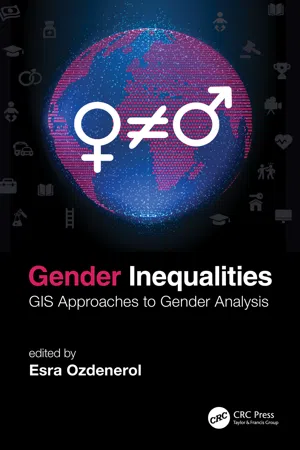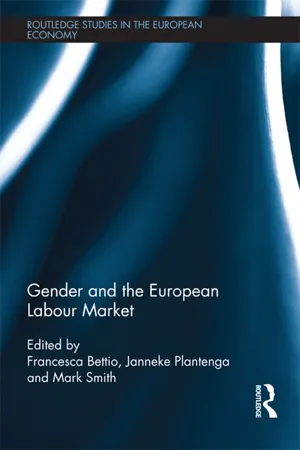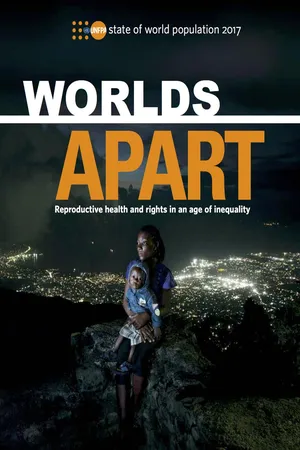Geography
Gender Inequality Index
The Gender Inequality Index (GII) is a measure of gender disparity that takes into account reproductive health, empowerment, and labor market participation. It provides a comprehensive assessment of gender inequality within a country, with higher values indicating greater disparities between men and women. The GII is a valuable tool for understanding and addressing gender inequality on a global scale.
Written by Perlego with AI-assistance
Related key terms
1 of 5
3 Key excerpts on "Gender Inequality Index"
- eBook - ePub
Gender Inequalities
GIS Approaches to Gender Analysis
- Esra Ozdenerol(Author)
- 2021(Publication Date)
- CRC Press(Publisher)
Figure 1.8 sheds new light on the position of women in 162 countries; it yields insights into gender gaps in major areas of human development. The component indicators highlight areas in need of critical policy intervention, and they stimulate proactive thinking and public policy to overcome systematic disadvantages of women. The Gender Inequality Index ranges from 0, where women and men fare equally, to 1, where one gender fares as poorly as possible in all measured dimensions. The countries with lower GII values have a higher success rate considering gender equality, as the GII measures the loss of success due to gender inequality. The worst-performing countries considering gender inequality are Yemen, the Central African countries, and Papa New Guinea. This is mostly due to the poor equality in empowerment and labor in these countries.FIGURE 1.8 Map of Gender Inequality Index (Mapped by Spatial Analysis and Geographic Education Laboratory, University of Memphis, Data source: UNDP-United Nations Development Program, Human Development Data 2019, http://hdr.undp.org/en/data . Accessed April 12, 2020).The Female Reproductive Health Index is used to assess a country’s sexual and reproductive health and rights (Barot et al. 2015). This index consists of the maternal mortality rate and the adolescent birth rate and is assessed on the following four grounds: preventing unintended pregnancies; abortion care; help through pregnancy phases, and preventing and treating STI’s. Figure 1.9 shows the care and support toward pregnant females, with lighter countries showing more support. Some countries have no data. As can be seen in Figure 1.9 - eBook - ePub
- Francesca Bettio, Janneke Plantenga, Mark Smith(Authors)
- 2013(Publication Date)
- Routledge(Publisher)
et al. 2010: 3). In contrast, the GII expresses inequality in terms of a certain reference standard – that is the situation in which the national scores on health, empowerment and labour market would be equal among men and women. Therefore, there is no absolute standard (the absence of gaps) but a relative, national-specific, standard.The different methodology also implies different concepts of equality. The GGI, the EUGEI and the index of Social Watch calculate the gender gap by simply taking the average across people and across dimensions. This presumes perfect substitutability between the dimensions: a low score on one dimension can be compensated by a high score on the other. The GII, on the other hand, takes the geometric means within groups. Taking the geometric mean implies that a low score on one dimension is no longer linearly compensated by a high score in another dimension. As a result there is no longer perfect substitutability between the dimensions. This method is therefore more ‘respectful’ of the intrinsic differences across the dimensions than a simple average. Taking the geometric means within groups also takes into account that the different dimensions of inequality may be correlated (‘overlapping’). This makes the GII an index, which is ‘association’ sensitive, implying that it adjusts for the association between the different dimensions of the index (Seth 2009 ).Focusing on gaps also raises the question of whether a negative–positive scale should capture the size and direction of the gender gap or whether it should be a one-sided scale. In a positive–negative scale the focus is purely on the existence of gaps. This means that a situation in which men outperform women is rated in the same way as a situation in which women outperform men. The EUGEI takes this position:Gender gaps are standardized in such a way that the values indicate the actual distance towards a situation of full gender equality. It gives no indication whether the actual inequality refers to a ‘negative’ gender gap (that is a gap to the disadvantage of women), or to a positive gender gap. - eBook - PDF
State of World Population 2017
Worlds Apart - Reproductive Health and Rights in an Age of Inequality
- United Nations Population Fund (UNFPA)(Author)
- 2017(Publication Date)
- United Nations Population Fund (UNFPA)(Publisher)
Log of GDP per capita UNDP Gender Inequality Index MORE INEQUALITY R 2 = 0.58759 4 6 8 10 12 0 0.1 0.2 0.3 0.4 0.5 0.6 0.7 0.8 0.9 FIGURE 20 Higher per capita gross domestic product correlates with less gender inequality Source: Gonzales et al. (2015a) THE STATE OF WORLD POPULATION 2017 49 Among girls and boys who enrol in secondary education, only a fraction complete upper secondary schooling. In the least developed countries, for example, 20 per cent of boys finish upper secondary education, compared with only 15 per cent of girls (UNICEF, 2016). Those who leave school early lack skills and knowledge needed to acquire higher-paying jobs. Subtle or overt pressure from, or discrimination by, teachers, can lead girls to forgo, or be excluded from, advanced science and mathematics courses, limiting their future occupational choices (Bassi et al., 2016; UNICEF, n.d.). Attainment of education in mathematics is a good predictor of career choices and future earnings (Nollenberger et al., 2016). The gender gap in mathematics is highly correlated with wage inequality (figure 21). In addition, education has been documented to reduce the incidence of adolescent pregnancy. The longer a girl stays in school, the less likely she is to be married as a child or to become pregnant (figure 22). This has long-term implications for labour-force participation and lifetime earnings. When girls are excluded from the educational opportunities that boys have, their future incomes will be lower than those of boys. Targeted efforts to increase educational equality have been found to narrow the wage gap between men and women. For example, women with a primary education in Pakistan earn 51 per cent of the incomes of their male counterparts, whereas women with a secondary education earn 70 per cent of the incomes of their male counterparts (UNESCO, 2013).
Index pages curate the most relevant extracts from our library of academic textbooks. They’ve been created using an in-house natural language model (NLM), each adding context and meaning to key research topics.


